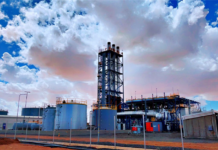
Mitsui O.S.K. Lines (MOL) has announced that Propeller Boss Cap Fins (PBCF), marketed by its group company MOL Techno-Trade (MOL Tech), have now been ordered for 3,500 vessels.
PBCF is an energy-saving device attached to the propeller of a vessel and breaks up the hub vortex generated behind the rotating propeller. MOL claims PBCF leads to energy savings of 3-5% compared to an identical vessel not equipped with PBCF, while higher fuel efficiency in turn cuts emissions of greenhouse gases (GHGs), reducing the shipping industry’s environmental impact.
PBCF can be installed on a propeller by bolt only and has no moving parts, which means there are no maintenance needs after the completion of the installation.
Co-developed by MOL, West Japan Fluid Engineering Laboratory and Mikado Propeller, which is now named Nakashima Propeller, PBCF system introduced in 1987.
MOL Tech, MOL, and Akishima Laboratories (Mitsui Zosen) Inc. have developed a new type of PBCG in 2017, which has already counted approximately 300 vessel installations. This upgraded PBCF features “a refined fin shape and height to further enhance its energy-saving effect,” according to a MOL statement.
“The development team has moved forward with research on a hybrid version with other energy-saving devices such as the Pre Swirl Fin and Energy-saving Rudder with Bulb Fins, and confirmed synergetic effects in a model test (Smart Wake Ship style), having similar wake flow to a full-scale ship,” explained MOL.
MOL said that PBFC can support in-service vessels to increase their fuel efficiency and comply with 2023 January effective standards, which will mandate the same level of efficiency as newbuilding ships.
Another environmentally friendly move from MOL is its participation in a zero-emission initiative called the “Wind Hunter Project”. MOL announced in late November that it has joined a wide-ranging corporate-academic partnership in the specific project, seeking new applications for hydrogen fuel and wind power.
The Wind Hunter Project combines wind propulsion sailing technology and wind energy converted to generate a stable supply of hydrogen.
MOL is currently working on the sailing development technology in the “Wind Challenger Project”. The Wind Hunter Project applies this sail technology and combines hydrogen carriers and fuel cells with hydrogen generated by electrolyzer which the power is generated by power generation turbine, according to an announcement.
MOL claims in its statement that this combination of sail and hydrogen technology will enable vessels to sail on schedule even in the periods of low wind and the project team plans to study about the application of supplying hydrogen generated at sea for onshore use.
Both of these applications are aimed at creating a zero-emission business free of any greenhouse gas (GHG) emissions.





